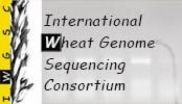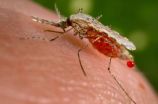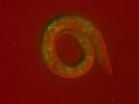(Press-News.org) Helicobacter pylori infection promotes stomach ulcers and cancer. How H. pylori initially interacts with and irritates gastric tissue is not well understood. An article published on July 17th in PLOS Pathogens now describes that H. pylori rapidly identifies and colonizes sites of minor injuries in the stomach, almost immediately interferes with healing at those injury sites, and so promotes sustained gastric damage.
Smoking, alcohol, excessive salt intake, and non-steroidal anti-inflammatory drugs cause damage to the tissue lining the stomach, and are associated with stomach ulcers. A team of scientists led by Marshall Montrose, from the University of Cincinnati, USA, asked whether H. pylori can sense and respond to such damage and so contribute to disease development.
The researchers induced small stomach lesions in anesthetized mice and observed that H. pylori bacteria can rapidly detect the injury site and navigate toward it. Within minutes, accumulation of bacteria interferes with repair of the tissue damage—and these results are the earliest indication showing H. pylori causing disease.
To examine how the bacteria accomplish this, the researchers also studied mice with larger stomach lesions (ulcers) that were subsequently infected with H. pylori. They found that H. pylori preferentially colonizes stomach tissue at injured ulcer sites, and there impairs healing of the damaged tissue. Selective colonization requires both bacterial motility and chemotaxis (the ability to change direction of movement in response to environmental cues), and higher levels of bacterial accumulation cause slower healing. However, when extremely high levels of immotile or chemotaxis-deficient bacteria are added to damaged tissue, they can also slow healing. As the researchers explain, "it's like a tag team race. Chemotactic machinery guides H. pylori into the damage site to colonize, and then other virulence factors take over to make sure the site stays just as tasty in the long term by slowing repair of any damage".
While the signals that attract H. pylori (but not benign stomach bacteria) toward injured tissue are not yet known, the researchers hope that their ability to rapidly measure H. pylori accumulation at the injured site now provides an experimental set-up to determine the factor(s) involved.
"The broader implications of our work", the researchers say, "are that even subclinical insults to the stomach that occur in daily life (damage from grinding of food, ingestion of alcohol, taking an aspirin) can potentially attract H. pylori and not only slow repair of any existing damage, but maybe also provide an initiation site that can start the pathogenic sequence of more severe stomach diseases caused by H. pylori".
INFORMATION:
Please contact plospathogens@plos.org if you would like more information about our content and specific topics of interest.
All works published in PLOS Pathogens are open access, which means that everything is immediately and freely available. Use this URL in your coverage to provide readers access to the paper upon publication:
http://dx.plos.org/10.1371/journal.ppat.1004275
Contact:
Marshall Montrose
e-mail: mhm@uc.edu
phone: +1.513.558.5636
Authors and Affiliations:
Eitaro Aihara, University of Cincinnati, USA
Chet Closson, University of Cincinnati, USA
Andrea L. Matthis, University of Cincinnati, USA
Michael A. Schumacher, University of Cincinnati, USA
Amy C. Engevik, University of Cincinnati, USA
Yana Zavros, University of Cincinnati, USA
Karen M. Ottemann, University of California at Santa Cruz, USA
Marshall H. Montrose, University of Cincinnati, USA
Funding: This work was supported by National Institutes of Health Grants RO1 DK54940 (MHM). The funders had no role in study design, data collection and analysis, decision to publish, or preparation of the manuscript.
Competing Interests: The authors have declared that no competing interests exist.
Citation: Aihara E, Closson C, Matthis AL, Schumacher MA, Engevik AC, et al. (2014) Motility and Chemotaxis Mediate the Preferential Colonization of Gastric Injury Sites by Helicobacter pylori. PLoS Pathog 10(7): e1004275. doi:10.1371/journal.ppat.1004275
Exploiting gastric vulnerability
How Helicobacter pylori identifies and colonizes sites of small injury in the stomach
2014-07-17
ELSE PRESS RELEASES FROM THIS DATE:
Genetic blueprint of bread wheat genome unveiled
2014-07-17
This news release is available in French, Japanese, and German.
The genetic blueprint is an invaluable resource to plant science researchers and breeders. For the first time, they have at their disposal a set of tools enabling them to rapidly locate specific genes on individual wheat chromosomes throughout the genome. Jorge Dubcovsky, Professor at the University of California Davis, USA, says that these results "have been a fantastic resource for our laboratory. The development of genome specific primers, which used to take several weeks of work, can now be done ...
New study shows how existing cropland could feed billions more
2014-07-17
MINNEAPOLIS / ST. PAUL (July 18, 2014) Feeding a growing human population without increasing stresses on Earth's strained land and water resources may seem like an impossible challenge. But according to a new report by researchers at the University of Minnesota's Institute on the Environment, focusing efforts to improve food systems on a few specific regions, crops and actions could make it possible to both meet the basic needs of 3 billion more people and decrease agriculture's environmental footprint.
The report, published today in Science, focuses on 17 key crops ...
New potential way to control spread of insect-borne disease
2014-07-17
A cross-disciplinary team is calling for public discussion about a potential new way to solve longstanding global ecological problems by using an emerging technology called "gene drives." The advance could potentially lead to powerful new ways of combating malaria and other insect-borne diseases, controlling invasive species and promoting sustainable agriculture.
Representing the Wyss Institute for Biologically Inspired Engineering at Harvard University, Harvard Medical School, Harvard School of Public Health, the Massachusetts Institute of Technology (MIT), Boston University, ...
In development, it's all about the timing
2014-07-17
Cold Spring Harbor, NY – Closely related organisms share most of their genes, but these similarities belie major differences in behavior, intelligence, and physical appearance. For example, we share nearly 99% of our genes with chimps, our closest relatives on the great "tree of life." Still, the differences between the two species are unmistakable. If not just genes, what else accounts for the disparities? Scientists are beginning to appreciate that the timing of the events that happen during development plays a decisive role in defining an organism, which may help to ...
Viral relics show cancer's 'footprint' on our evolution
2014-07-17
Viral relics show cancer’s ‘footprint’ on our evolution Cancer has left its ‘footprint’ on our evolution, according to a study which examined how the relics of ancient viruses are preserved in the genomes of 38 mammal species.
Viral relics are evidence of the ancient battles our genes have fought against infection. Occasionally the retroviruses that infect an animal get incorporated into that animal’s genome and sometimes these relics get passed down from generation to generation – termed ‘endogenous retroviruses’ (ERVs). Because ERVs may be copied to other parts of the ...
When is a molecule a molecule?
2014-07-17
Using ultra-short X-ray flashes, an international team of researchers watched electrons jumping between the fragments of exploding molecules. The study reveals up to what distance a charge transfer between the two molecular fragments can occur, marking the limit of the molecular regime. The technique used can show the dynamics of charge transfer in a wide range of molecular systems, as the scientists around Dr. Benjamin Erk and Dr. Daniel Rolles of DESY and Professor Artem Rudenko of Kansas State University report in the scientific journal Science. Such mechanisms play ...
Pitt-led study suggests cystic fibrosis is 2 diseases, 1 doesn't affect lungs
2014-07-17
PITTSBURGH, July 17, 2014 – Cystic fibrosis (CF) could be considered two diseases, one that affects multiple organs including the lungs, and one that doesn't affect the lungs at all, according to a multicenter team led by researchers at the University of Pittsburgh School of Medicine. The research, published online today in PLOS Genetics, showed that nine variants in the gene associated with cystic fibrosis can lead to pancreatitis, sinusitis and male infertility, but leave the lungs unharmed.
People with CF inherit from each parent a severely mutated copy of a gene ...
Scientists find protein-building enzymes have metamorphosed & evolved new functions
2014-07-17
LA JOLLA, CA AND JUPITER, FL—Scientists at The Scripps Research Institute (TSRI) and Hong Kong University of Science and Technology (HKUST) and their collaborators have found that ancient enzymes, known for their fundamental role in translating genetic information into proteins, evolved myriad other functions in humans. The surprising discovery highlights an intriguing oddity of protein evolution as well as a potentially valuable new class of therapeutic proteins and therapeutic targets.
"These new protein variants represent a previously unrecognized layer of biology—the ...
A new stable and cost-cutting type of perovskite solar cell
2014-07-17
Perovskite solar cells show tremendous promise in propelling solar power into the marketplace. The cells use a hole-transportation layer, which promotes the efficient movement of electrical current after exposure to sunlight. However, manufacturing the hole-transportation organic materials is very costly and lack long term stability. Publishing in Science, a team of scientists in China, led by Professor Hongwei Han in cooperation with Professor Michael Grätzel at EPFL, have developed a perovskite solar cell that does not use a hole-transporting layer, with 12.8% conversion ...
Scientists complete chromosome-based draft of the wheat genome
2014-07-17
MANHATTAN, Kansas — Several Kansas State University researchers were essential in helping scientists assemble a draft of a genetic blueprint of bread wheat, also known as common wheat. The food plant is grown on more than 531 million acres around the world and produces nearly 700 million tons of food each year.
The International Wheat Genome Sequencing Consortium, which also includes faculty at Kansas State University, recently published a chromosome-based draft sequence of wheat's genetic code, which is called a genome. "A chromosome-based draft sequence of the hexaploid ...
LAST 30 PRESS RELEASES:
Climate extremes triggered rare coral disease and mass mortality on the Great Barrier Reef
Direct observation reveals “two-in-one” roles of plasma turbulence
Humans rank between meerkats and beavers in monogamy ‘league table’
US fossil reveals early mass-burial event and ancient microbial attack
Sedative choice could improve outcomes for breathing tube patients
New superconducting thin film for quantum computer chips
Simulations reveal protein "dynamin" constricts cell membranes by loosening its grip
Nearly 1 in 5 UK emergency department patients cared for in corridors/waiting rooms
Heavy energy drink intake may pose serious stroke risk, doctors warn
Violence against women and children among top health threats: New global study reveals disease burden far larger than previously estimated
Predicting who is at risk of developing type 1 diabetes, as new drugs now available
New gene-mapping method unlocks hidden drivers of cancer
Ocean current and seabed shape influence warm water circulation under ice shelves
Call to increase funding for ‘invisible’ Deaf victim-survivors of domestic abuse
University of Maryland School of Medicine names distinguished scientist and academic leader Gerald M. Wilson, PhD, as Chair of the Department of Biochemistry and Molecular Biology
Receptors in mammary glands make livestock and humans inviting hosts for avian flu
Icy hot plasmas
Treating adults with autism: Maryland Clinical Center offers national blueprint for care after pediatric transition
University of Phoenix College of Doctoral Studies releases white paper on reclaiming control to build workforce resilience
NCCN Summit seeks to improve care for veterans and first responders with cancer from line-of-duty exposure
ERC Consolidator Grant for soft robotics researcher
Dual-action arts and wellbeing program transforms dementia care
The global plastic waste trade contributes to coastal litter in importing countries, study shows
UT Dallas partners with Tech Mahindra on AI innovation
Blinking less could signal the brain is working harder to listen, Concordia study shows
Male bonobos track females’ reproductive cycle to maximize mating success
New report outlines science priorities for human Mars exploration
Want to curb cannabis-related crashes? Don’t forget older adults, study finds
Expectant management vs medication for patent ductus arteriosus in preterm infants
Pew funds 7 new biomedical research collaborations
[Press-News.org] Exploiting gastric vulnerabilityHow Helicobacter pylori identifies and colonizes sites of small injury in the stomach



